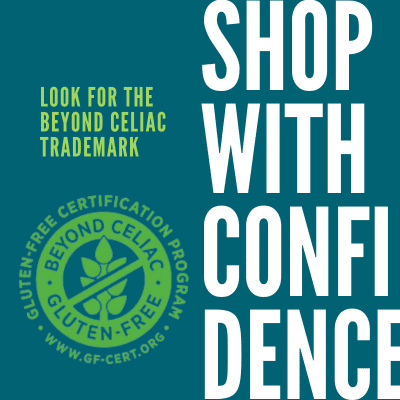Gluten in Medications Research Report
Q&A with the research report’s authors
In 2011, Beyond Celiac received a $50,000 grant from the U.S. Food and Drug Administration (FDA) to fund the first scientific research in the area of gluten in medication. This preliminary research aimed to help the FDA and others better understand the countless stories of adverse experiences associated with gluten in medications that are regularly reported by the celiac disease and gluten sensitive populations. Findings from this project will provide a foundation for future investigation within the FDA and scientific communities, through which additional research, labeling, and safe use guideline initiatives can advance. Beyond Celiac partnered with Loretta Jay, MA, President of Parasol, LLC and consultant to Beyond Celiac and Robert A. Mangione, RPh, EdD, Provost and Professor of Pharmacy at St. John’s University and Beyond Celiac Scientific/Medical Advisory Council member, and Dr. Mangione’s research colleagues at St. John’s University , to execute the study.
A critical part of this research study was the launch of a national survey completed by more than 5,600 individuals to qualify the suspected adverse drug reactions caused by gluten. Beyond Celiac would like to sincerely thank those who participated in this research – without your participation we would not have been able to complete this landmark study.
In fall 2014, Beyond Celiac delivered the study’s final report to the FDA. You can read this full report here.
Now, Beyond Celiac would like to help you understand our study a little bit better. We are very excited about this study’s results, so we teamed up with the study’s two primary investigators, Loretta Jay, MA and Robert A. Mangione, RPh, EdD to answer some questions about the research.
Key Study Findings
Question 1
Q: Overall, what are the key findings of the research and what should celiac disease and gluten sensitive patients consider when consuming medications?
A: This study portrayed the problem of unlabeled gluten in medicine for people with celiac disease and gluten sensitivity, and then provided a better understanding of the circumstances that led to reported adverse drug events. Patients and healthcare providers’ inability to accurately determine if gluten is an ingredient in ingested medicine poses numerous problems. It leads to changed treatment plans and purchasing decisions, takes an emotional toll on patients, and results in a financial cost as well. Clear, unambiguous language about the inactive ingredients in medicine will alleviate these undesirable effects.
Another key finding relates to the actual methods used to test for gluten in medicine. Commercially available assays are designed to test for gluten in food – not drugs. Because the size of some medications’ dosage forms is considerably smaller than food samples, our lab team experienced some problems. We recommend that the manufacturers of the assays be included in future stakeholder discussions and that improved testing protocols be pursued. (More on this can be found below, in Question/Answer # 9.)
This study provides the foundation for additional research. In addition to identifying better testing methods, determining if there is clinical significance to amount of gluten that was found to be in medicines is needed. Until these steps are realized, people who must medically refrain from ingesting gluten should continue to be informed consumers: review ingredient labels, contact manufacturers when the labels are unclear, and work in collaboration with their healthcare providers to make the best medical decision possible with the information that is available.
Question 2
Q: What does it mean to “qualify” patients’ anecdotal reports and why was this such an important aim of your work?
A: Prior to this study, all patient reports of adverse reactions to gluten in medicine were anecdotal. This means that they were personal accounts of individuals’ experiences. Because there was no formal assessment of these findings, researchers and policy-makers were unable to rely on the validity of the experiences to make policy decisions. By qualifying the anecdotal reports, we created parameters of what was considered relevant and evaluated the various categories of experiences.
Question 3
Q: Highly processed ingredients derived from wheat, such as caramel coloring, dextrin, glucose syrup, and maltodextrin, are generally considered safe for individuals with celiac disease and other gluten-related disorders to consume. The way these ingredients are processed renders the amount of gluten in the final product safe for those with a medical need to be gluten-free. In this study, some of these highly processed products – dextrin, dextrimaltose, and caramel coloring – were listed as “red flag ingredients,” though maltodextrin was not. Is there a reason dextrin, dextrimaltose, and caramel coloring were included even though they are generally considered “safe” ingredients in foods?
A: Inactive ingredients in medications are frequently sourced from a global supply chain, and suppliers may change without notice. The scientific documentation regarding the gluten content of these ingredients when they are in medication is inconsistent. As such, we decided to include these ingredients on the “red flag” list in order to give the consumer and healthcare provider as much information as possible when making their treatment care decisions.
Question 4
Q: This study found that 25% of the survey participants reported experiencing adverse events to medication due to suspected gluten exposure. Is that number representative of the entire celiac disease and gluten sensitive patient population? Why or why not?
Answer: The survey participants are not representative of the entire celiac and non-celiac gluten sensitive (NCGS) populations. This is for two primary reasons:
- The topic of the survey, Gluten in Medicine, was publicized when the survey was distributed. As a result, people who thought that they had a negative experience with gluten in medicine were more likely to participate in the survey. This could skew the sample of participants.
- Most of the people who took the survey were affiliated with a celiac organization. This association suggests that they are more likely to be aware of their gluten-free diet and lifestyle, and perhaps are looking for additional supports to successfully manage it.
Question 5
Q: On page 19, you briefly touched upon the fact that some people will attribute negative side effects of a medication (adverse drug reaction) to gluten exposure (adverse drug event.) You also highlight that there is some overlap between drug side effects (adverse drug reaction) and the symptoms of celiac disease and other gluten-related disorders. In light of this, can you further explain why it is important to differentiate between adverse drug reactions and adverse drug events?
A: We think it is important to recognize that how an individual perceives the cause of their reaction to a drug is just as important as what that reaction is. Side effects (adverse drug reactions) are reactions to a drug that are expected and known, but not the intended therapeutic outcome. Many medications’ side effects are very similar or the same as what someone with celiac disease might experience if he or she ingests gluten from a medication (adverse drug event.) When healthcare providers or consumers are unable to determine if there is gluten in a drug, they might make an assumption that gluten caused the negative reaction – even if the reaction is a known side effect of the medication (adverse drug reaction.)
Ingesting gluten is toxic to someone with celiac disease. The ramifications go beyond the immediate manifestation of noticeable symptoms. Internally, gluten exposure causes malabsorption and leads to an increased risk of related disorders. If the gluten content of medication is known, then the healthcare team (including the patient) can make a treatment plan based on sound information. When the gluten content of a medication is unknown, the healthcare team must speculate about the cause of the adverse event, and in an attempt to avoid possible exposure to gluten, may unnecessarily switch the treatment to a less effective medication regimen. Individual consumers may also independently decide to discontinue the use of effective and needed nonprescription medication because they suspect that it contains gluten if the label does not specify that it is gluten-free.
What the Gluten-Free Consumer Needs to Know & What They Can Do
Question 6
Q: What would you say to gluten-free consumers who regularly consume the three drugs that tested positive – over-the-counter (OTC) drug Acetaminophen/dextromethophan HBr/doxylamine liquid capsules and the prescription (Rx) drugs sertraline HCl film coated 50 mg tablets and omeprazole 40 mg capsules?
A: The primary focus of this study was to better understand how gluten in medicine affects people with celiac disease and gluten sensitivity. The testing of medications was intended to inform that process, with only a select number of medications tested. Additional research is needed to better understand what the clinical significance of gluten in a particular drug is.
Further challenging the process of determining gluten content in medications is the knowledge that inactive ingredients may change from manufactured batch to batch. It should be noted that we did not test the medication from the same lot or manufacturing batch as was reported by the survey participant, as time may have elapsed from the date of the suspected reaction to when the survey was completed. Similar to safe food practices, consumers should talk with their pharmacist about the potential for gluten being present in dosage form’s inactive ingredients each time they fill a prescription, carefully check the label of the OTC drugs that they purchase, and call the manufacturer if unsure if gluten is in a drug product. We always encourage people to talk with their healthcare provider to help with this determination, if necessary. If someone believes that they’ve experienced a gluten-related reaction after starting a new medicine, then they should consult with their healthcare provider to determine the best course of treatment for them.
Question 7
Q: Of the three drugs that tested positive, two of them did not contain any “red flag” ingredients. Since gluten-free consumers are regularly encouraged to rely on label reading to ensure their safety, what implications does this have on this advice? Do you suggest the community add in any new steps to the list of actions they can take to safely use medications? Furthermore, if “red flag” ingredients are not the only concern, where do we go from here?
A: This is a preliminary study. We are still learning about how gluten in medicine is detected and affects the celiac and gluten-sensitive populations. In addition, we need a better understanding about how inactive ingredients are selected and used in the drug manufacturing process. Including manufacturers in stakeholder discussions will further this goal.
Consumers should contact manufacturers directly if they are unsure of the gluten content of their medication.
Study Methodology, Testing
Question 8
Q: Can you explain the difference between an “adverse clinical effect” and an “adverse morphological effect” as a result of gluten exposure (p. 20)? Why is it important to identify the type of effect that a patient experiences?
A: When people with celiac disease experience noticeable manifestations of gluten exposure, it is referred to as an adverse clinicaleffect: a symptom that the patient and/or healthcare provider can observe, e.g. vomiting or diarrhea, headaches, skin rash, etc. As little as 0.015 mg of ingested gluten per day may cause an adverse clinical effect. A slice of wheat bread contains 1.5g of gluten, so 0.015mg of gluten is about 0.001% of a slice of wheat bread.
Adverse morphological effects are negative health effects that are not readily evident to the affected person. For example, villous atrophy may be observed on biopsy of the small intestine, or blood work may indicate the high likelihood of gluten exposure. Compared to the amount of ingested gluten that can cause clinical effects, a slightly higher amount is likely needed to cause morphological effects: 0.4 mg/day. That is about 0.0267% of a slice of wheat bread.
Differentiating between a clinical and a morphological effect is important, because untreated celiac disease (continued gluten exposure) resulting in morphological effects can lead to serious health consequences including malabsorption and secondary diseases.
Question 9
Q: In this study, you used the competitive ELISA and the sandwich ELISA to test for gluten in medications. However, these assays are primarily used to test for gluten in foods. Currently, we do not have any validated assays to specifically test for gluten ingredients in medications, which you address on page 18, and you point out the importance of this finding in your closing remarks. How does the lack of verified testing methods for gluten in medications impact the outcomes of this study? What do you suggest should be done in the future?
A: The testing kits used in this study are intended to test for gluten in food. Because the size of the medication samples that were tested were much smaller than food samples, this posed some challenges for the lab team. The testing kits have not been validated to test for gluten in medicine. This means that the testing kit manufacturers have not conducted studies to ascertain the accuracy of the assays when testing medication.
Including testing kit manufacturers in stakeholder discussions about gluten in medicine will enhance the meaningfulness of next steps, including the best way to identify if gluten is in a medication.
Question 10
Q: On page 17, you highlight that products that test above the 20 parts per million (ppm) threshold, but that do not contain any red flag ingredients, may have falsely tested positive with the assay. What is a false positive and how could it occur?
A: The term “false positive” is used to indicate when a test result is erroneously found to be positive. It occurs because of imperfect testing methods or procedures.
The manufacturer of the testing kits, R-Biopharm, tells us that there isn’t any evidence of cross-reactivity (an atom, molecule, or radical undergoing a chemical reaction) with the R7021 antibody that was used in their testing kits that might have cause a false positive. Available testing kits are intended to test food products, not medication. Because medication samples provide a very small sample size there may need to be a different process to test them. Pages 17-18 in the report explain in greater detail why we recommend that testing methods receive additional exploration.
In addition, other causes for a false positive could be human error with the testing procedures or contamination in the lab.
Question 11
Q: Why would the three drugs that tested positive, test positive on the competitive ELISA but not the sandwich ELISA?
A: When some proteins are hydrolyzed (i.e. broken down) they may not have enough of the gluten molecule (epitope) to be recognized by the antibody in the sandwich testing kit. The competitive assay only requires one epitope and can detect the protein where the sandwich assay requires two epitopes, and could not.
Question 12
Q. Where can I find the full public report?
A. Click here for the full technical research report, “Gluten in Medication: Qualifying the extent of exposure to people with celiac disease and identifying a hidden and preventable cause of an adverse drug event.”
Future Directions – Where do we go from here?
Question 13
Q: On page 15, you state that you hope “action will be taken so individuals following a medically required gluten-free diet will have access to the full spectrum of available medications and also can avoid preventable harm.” What specific actions would you suggest be taken to meet these goals?
A: Providing accurate details about the gluten ingredients in a drug product will eliminate guesswork and enable healthcare providers and consumers to make treatment plan decisions that are based on reliable information. Specific steps to meet this goal include:
- Improved collaboration between gluten in medicine stakeholders, including manufacturers of gluten assays
- Development of improved testing methods to test for gluten in medicine
- Manufacturers to know and clearly communicate to consumers and healthcare providers if gluten is present in an inactive ingredient in a medication
 Loretta Jay, MA, is President of Parasol, LLC, and has more than twenty-five years of experience in comprehensive program design, implementation and evaluation, including wide-ranging experience in the design and conduct of accredited educational programs and research studies. With a Master’s degree in Community Psychology, Ms. Jay’s writing about celiac disease and food allergy has been published domestically and internationally; public health officials, legislators and policy-makers at the federal, state and local levels call upon her for guidance to yield improved services and streamline policy and protocols about medically required food restrictions to better meet the population’s needs.
Loretta Jay, MA, is President of Parasol, LLC, and has more than twenty-five years of experience in comprehensive program design, implementation and evaluation, including wide-ranging experience in the design and conduct of accredited educational programs and research studies. With a Master’s degree in Community Psychology, Ms. Jay’s writing about celiac disease and food allergy has been published domestically and internationally; public health officials, legislators and policy-makers at the federal, state and local levels call upon her for guidance to yield improved services and streamline policy and protocols about medically required food restrictions to better meet the population’s needs.
 Robert Mangione, RPh, Provost and Professor of Pharmacy, has been a member of the St. John’s University faculty for over 35 years. He earned his B.S. in Pharmacy and M.S. in Pharmaceutical Sciences (Clinical Pharmacy) from St. John’s University College of Pharmacy and Health Sciences as well as a P.D. and an Ed.D. in Educational Administration and Supervision from St. John’s University, School of Education. His research interests include Pharmaceutical Care for Patients with Celiac Disease, Pediatric Pharmacotherapy, and Poverty Issues in Healthcare and Education. He has authored or co-authored over 100 publications in the professional literature.
Robert Mangione, RPh, Provost and Professor of Pharmacy, has been a member of the St. John’s University faculty for over 35 years. He earned his B.S. in Pharmacy and M.S. in Pharmaceutical Sciences (Clinical Pharmacy) from St. John’s University College of Pharmacy and Health Sciences as well as a P.D. and an Ed.D. in Educational Administration and Supervision from St. John’s University, School of Education. His research interests include Pharmaceutical Care for Patients with Celiac Disease, Pediatric Pharmacotherapy, and Poverty Issues in Healthcare and Education. He has authored or co-authored over 100 publications in the professional literature.


